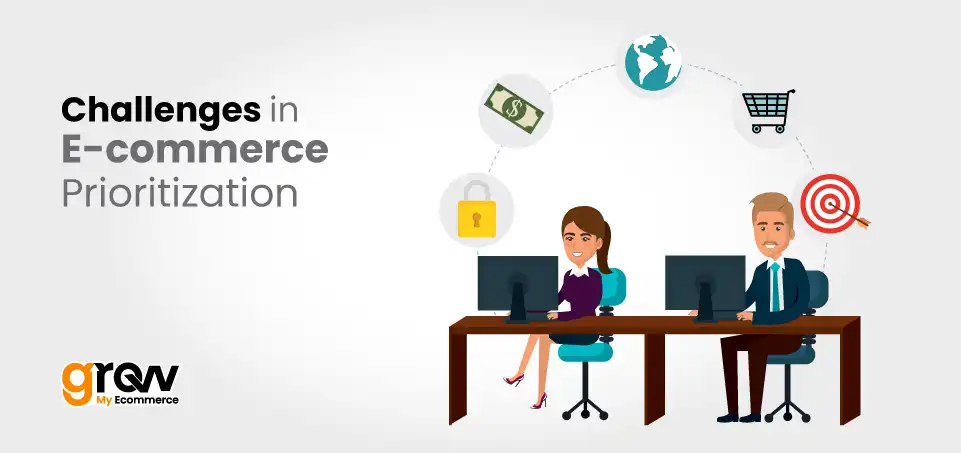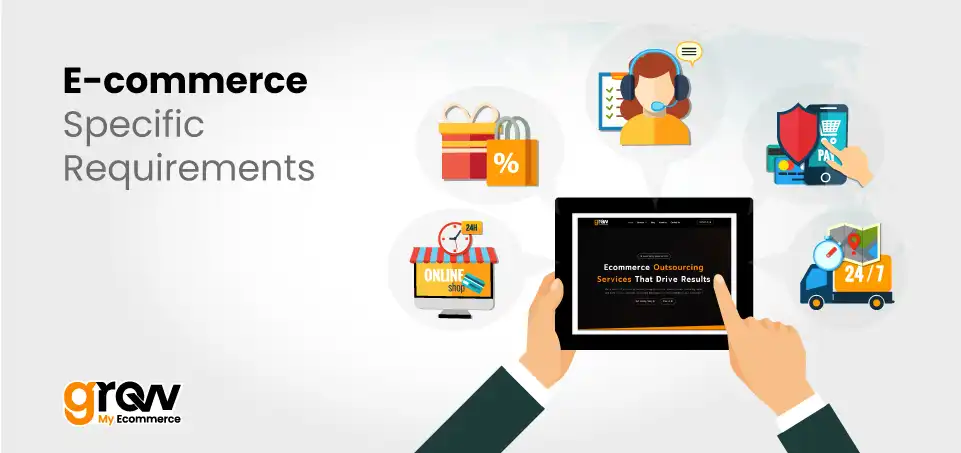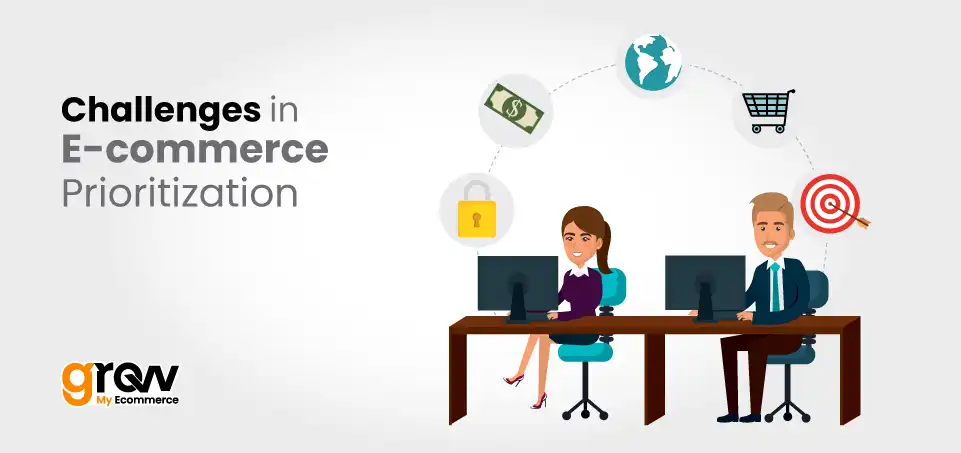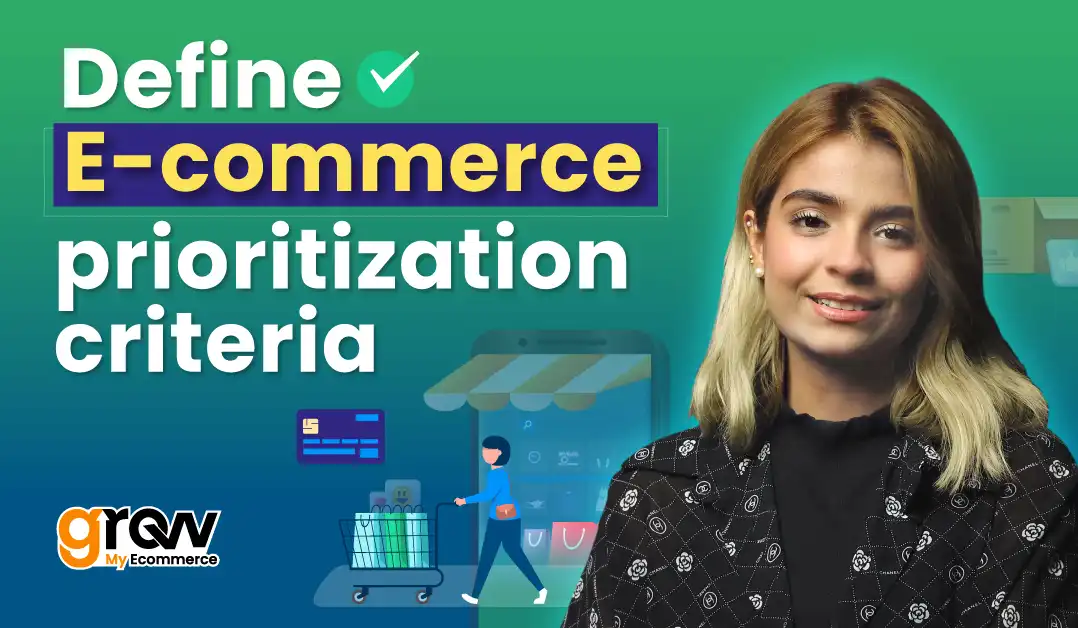So, you’re running an ecommerce business with endless ideas, opportunities, and potential growth avenues.
The only problem is -your time, resources, and energy are limited and you can’t do everything at once.
But you also can’t afford to prioritize the wrong things.
This brings the ultimate question for every ecommerce strategist: how to define ecommerce prioritization criteria?
Well, the answer to defining ecommerce prioritization criteria lies in a systematic approach; you need to-
- Identify Business Objectives
- Understand User Needs and Expectations
- Define Impact Areas
- Establish Evaluation Metrics
- Create a Scoring Framework
- Balance Short-Term and Long-Term Initiatives
- Incorporate Customer Feedback
- Check Market Trends and Do Competitor Analysis
- Use Prioritization Frameworks
- Collaborate with Stakeholders
- Regularly Reassess Prioritization
This is just the beginning of mastering ecommerce prioritization. We’ll explore each step in detail, offering insights and examples to guide you. Keep reading to fine-tune your ecommerce prioritization strategy and make every decision count.
Understanding Ecommerce Prioritization Criteria

Definition
Ecommerce prioritization criteria are a structured set of guidelines used to evaluate and rank tasks, projects, or initiatives based on their potential impact, feasibility, and alignment with business objectives.
These criteria help businesses determine what to focus on, ensuring that resources are allocated to initiatives that deliver the most value.
Why Prioritization Matters in ecommerce
Prioritization is the backbone of an efficient ecommerce strategy. With countless opportunities for growth, marketing campaigns to launch, and features to implement, businesses must discern what truly drives value.
Without a clear prioritization process, teams risk wasting resources on low-impact activities, missing critical deadlines, or focusing on initiatives that don’t align with the company’s long-term vision.
Here are just a few benefits of ecommerce prioritization.
- Achieve Business Goals
Not every feature deserves equal attention. Prioritization ensures you invest in what aligns with your business. For example, if boosting repeat purchases is your goal, focus on loyalty programs or personalized recommendations rather than flashy, less-impactful features.
- Enhancing the Customer Experience
A tailored shopping experience keeps customers coming back. Prioritizing features like intuitive navigation or smart product suggestions makes users feel valued. But ignoring what impacts their experience like fixing a clunky checkout can drive them away fast. The right focus creates smooth, satisfying customer journeys.
- Preparing for Growth and Change
Ecommerce doesn’t stand still. Prioritizing scalability ensures your platform grows with market demands. Whether it’s choosing flexible tech or features that can adapt, smart planning makes sure your platform stays competitive as trends evolve. Think of it as future proofing your business.
- The Risks of Poor Prioritization
Focusing on the wrong areas can lead to wasted time, confused users, and even lost customers. For example, launching multiple features without fixing existing pain points, like slow page loads, can leave customers frustrated and lose loyalty.
- Improved Resource Allocation
When you know what matters most, resources flow where they’re needed. Teams can focus their efforts on impactful projects rather than being stretched thin. It allows everyone to work smarter, not harder, leading to better results without burnout.
- Enhanced Customer Experience
Prioritizing means offering customers solutions to their most pressing needs. Whether it’s fast load times, easy navigation, or personalized product displays, every feature feels purposeful. When customers feel cared for, satisfaction and loyalty grow, boosting your bottom line.
- Faster Time-to-Market for Impactful Projects
Clear priorities mean quicker execution. Instead of trying to do it all, you focus on high-value features and roll them out faster. This agility allows you to meet market demands and stay competitive without unnecessary delays.
Steps to Define Ecommerce Prioritization Criteria
Ecommerce businesses operate in competitive and constantly evolving markets. Prioritization ensures resources are allocated to initiatives that align with your goals, deliver the greatest impact, and contribute meaningfully to both short-term wins and long-term growth.
A clear understanding of how to define ecommerce prioritization criteria can boost customer satisfaction, streamline resource allocation, and ensure faster time-to-market for impactful upgrades.
Here’s how to establish a framework for prioritizing your efforts.
1. Align with Business Goals
The first question to ask yourself is, “What are we trying to achieve?” Every prioritization decision should tie directly back to your overarching business objectives. If your goal is to boost customer retention, for instance, focus on initiatives like loyalty programs or improving your post-purchase experience.
If increasing revenue is your aim, strategies like upselling or cross-selling might take center stage.
Define these high-level objectives clearly. Whether it’s increasing your average order value (AOV), expanding into new customer segments, or improving customer satisfaction, having these goals will act as your compass.
Without them, it’s easy to get swept up in ideas that sound good but don’t drive real progress.
2. Zero in on Your Key Impact Areas
Not all projects are created equal. Some will directly impact your growth or operations, while others (like small tweaks or aesthetic changes) might not move the needle as much. Here’s where identifying key impact areas comes in.
Ask questions like:
- What is the revenue potential of this initiative?
- How many customers will it impact, and how significantly?
- Will this enhance our operational efficiency or cut costs?
- Can this help us stand out in a crowded market?
You can group your activities into categories such as marketing, sales, website development, and customer experience. This helps to systematically evaluate which areas will bring the biggest bang for your buck.
3. Establish Clear and Measurable Metrics
Let’s face it, gut feelings can only take you so far. You need metrics to gauge the value of your initiatives objectively. For instance, if you’re planning a new feature for your site, consider how you’ll evaluate it. Will it increase website traffic? Improve conversion rates? Enhance customer lifetime value?
Beyond these, think about metrics like ROI (Return on Investment), feasibility (both technical and operational), and time-to-value. Will this initiative bear fruits quickly, or is it a longer-term play? If it’s scalable and can support big-picture growth, it should rank higher on your list.
4. Create a Weighted Scoring System
Here’s where things get fun scoring can really streamline decision-making. Build a scoring system that uses weights based on priority areas. For example:
- Revenue potential might have 40% weight,
- Customer impact 30%,
- Effort required 20%,
- Time-to-impact 10%.
Each initiative gets a score between 1 and 5 in these categories. Multiply each score by its weight, add them up, and voilà you have a clear ranking of what should be tackled first.
5. Prioritize Customer Feedback
Your customers are an invaluable resource. They’ll often highlight problems or opportunities that might not even be on your radar. Regularly gather insights through surveys, reviews, and behavioral analytics.
For instance, if customers repeatedly mention difficulty navigating your website, prioritizing a smoother UX over a flashy marketing campaign makes sense. By addressing pain points directly, you build loyalty and trust. These are two invaluable currencies in ecommerce.
6. Balance Short-Term Wins and Long-Term Vision
A good priority list should strike a balance between quick wins and strategic initiatives. Short-term wins, like optimizing your email signup process or running a targeted campaign, deliver immediate value.
But don’t ignore the long haul goals, such as adopting new technologies or expanding to untapped markets, which will secure future growth. Some initiatives may not show immediate results but could be game changers down the line.
7. Keep an Eye on Competitors and Industry Trends
If you’re not keeping an ear to the ground, you might miss critical opportunities. Competitor analysis and market trends should factor into your prioritization decisions.
Are competitors excelling at mobile-first design? Are industry leaders stepping into VR shopping experiences? Use this intel to inform your strategy.
But don’t simply copy, instead, find ways to differentiate. If everyone is doing free shipping, could you go a step further with same day delivery?
8. Use Visualization and Collaboration Tools
Visualizing priorities can help bring clarity to the decision-making process. Tools like the Eisenhower Matrix or RICE Scoring can help categorize tasks by urgency, impact, and effort.
Additionally, collaborative platforms like Airtable, Trello, or Asana make it easier to involve stakeholders and keep everyone in the loop.
For example, the RICE model (Reach × Impact × Confidence ÷ Effort) works wonders for identifying high-impact, low-effort initiatives. Mapping everything out visually ensures nothing gets lost in the shuffle.
9. Get Stakeholders Onboard
Speaking of collaboration, it’s crucial to involve all relevant stakeholders, from marketing to ops to tech teams. Everyone should feel included in the prioritization process.
After all, these projects will likely affect multiple departments. Getting upfront buy-in prevents misaligned goals or last-minute roadblocks later.
10. Regularly Review and Refine
Ecommerce is never static. What worked six months ago might not resonate anymore. Set a cadence (quarterly or semi-annually) for reassessing your prioritization framework. Revisit your scoring criteria and update it based on evolving needs, market shifts, or fresh analytics.
For instance, if customer behaviors change due to economic factors, your focus areas might need some reshuffling.
Just keep things dynamic, you will ensure that your ecommerce strategy remains current and impactful.
Popular Frameworks for Ecommerce Prioritization
There are several popular frameworks and methods available to help with prioritization in ecommerce. Here are a few examples:
| Framework | Best For | Key Factors | Formula/Method | Example Use |
| MoSCoW Method | Simple, high-level prioritization | Must-Have, Should-Have, Could-Have, Won’t-Have | Categorize into four groups based on priority. | Secure payment gateway (Must-Have) vs. AR previews (Could-Have). |
| RICE Scoring | Data-driven decisions | Reach, Impact, Confidence, Effort | RICE Score = (Reach × Impact × Confidence) / Effort | Product recommendations (high impact) vs. chatbot (low reach). |
| Value vs. Effort Matrix | Quick prioritization with minimal data | High Value vs. Low Effort | Plot features on a 2×2 grid: High/Low Value & Effort. | One-click checkout (High Value, Low Effort). |
| Kano Model | Understanding customer satisfaction | Basic Needs, Performance Needs, Exciters/Delighters | Classify features based on customer satisfaction impact. | Fast loading (Basic Need), AI personalization (Exciter). |
| ICE Scoring | Simple scoring with less data | Impact, Confidence, Ease | ICE Score = Impact × Confidence × Ease | Free shipping scores higher than analytics dashboards. |
| Weighted Scoring | Custom prioritization aligned with goals | Criteria weighted by importance | Score features against weighted criteria. | Improving search scores higher than adding seasonal themes. |
| Opportunity Scoring | Identifying areas for improvement | Importance vs. Satisfaction | Focus on important features with low satisfaction. | Focus on product filters if importance is high but satisfaction is low. |
| WSJF (Weighted Shortest Job First) | Agile environments | Cost of Delay, Job Size | WSJF = Cost of Delay / Job Size | Mobile responsiveness (high CoD) over custom loyalty program. |
MoSCoW Method for Clear Prioritization
The MoSCoW method is a straightforward framework that categorizes tasks into Must-Have, Should-Have, Could Have, and Won’t Have. This approach is ideal for high-level prioritization, ensuring critical features are addressed first while deferring less essential ones.
RICE Scoring for Data-Driven Decisions
RICE scoring helps ecommerce teams make data-informed choices by evaluating Reach, Impact, Confidence, and Effort. This structured method allows for an objective ranking of features based on their potential value and implementation feasibility.
Using the Value vs. Effort Matrix
The Value vs. Effort Matrix is a visual prioritization tool that balances the impact of a feature against the resources required to implement it.
It’s perfect for quickly identifying high-value, low-effort initiatives to maximize ROI.
The Customer-Focused Kano Model
The Kano Model categorizes features based on their impact on customer satisfaction. By identifying basic needs, performance enhancers, and exciting innovations, this framework helps ecommerce businesses prioritize features that delight users.
ICE Scoring for Simplicity and Speed
The ICE framework evaluates initiatives based on Impact, Confidence, and Ease of implementation. It’s a simplified version of RICE, making it ideal for teams needing quick prioritization without extensive data.
Weighted Scoring for Goal Alignment
Weighted Scoring allows ecommerce businesses to tailor prioritization to their specific goals. By assigning weights to factors like revenue potential, user experience, and strategic value, teams can focus on features that align with their objectives.
Opportunity Scoring to Identify Gaps
Opportunity Scoring focuses on user feedback by comparing the importance of features to customer satisfaction. This method prioritizes improvements that address dissatisfaction with high-priority functionalities.
WSJF: An Agile Prioritization Framework
Weighted Shortest Job First (WSJF) is designed for agile environments, ranking features based on their Cost of Delay relative to the effort required. It ensures teams deliver maximum value in the shortest time.
The Importance of ecommerce-Specific Requirements

When it comes to building a successful ecommerce platform, nailing down clear and specific requirements is absolutely essential. Think of it as creating a solid foundation for your dream house.If you skip the planning stage, you’re setting yourself up for trouble later on.
These requirements can be broadly divided into two categories: functional and non-functional. Both play a vital role and understanding them can make all the difference in ensuring your platform not only works but thrives.
Functional Requirements
Functional requirements are all about what your ecommerce platform does. These include the features and tools that make your customers’ experience smooth and enjoyable. Picture this search functionality that helps users find exactly what they’re looking for, an intuitive shopping cart system, secure payment integration, or a seamless checkout process. Each of these is a functional piece of the puzzle.
Without these, customers can quickly become frustrated. Imagine browsing a site only to find you can’t easily search for what you need or the payment system feels clunky.
Issues like these are deal-breakers and can send customers straight to your competitors. A well-thought-out set of functional requirements ensures you’re meeting user expectations and creating a platform people want to return to.
Non-Functional Requirements
While functional requirements focus on what the system does, non-functional requirements are about how the system performs. These include aspects such as speed, scalability, reliability, and security.
For instance, does your platform load quickly enough to keep users engaged?
Can it handle a sudden surge in traffic during seasonal sales?
Is your data secure to protect customers’ sensitive information?
Getting these non-functional areas right reinforces trust and ensures your system performs consistently, even under pressure.
They may not be as flashy as functional features, but trust me, they are just as important.
Why Prioritization Is Key
Now, this is where it gets interesting & prioritizing requirements. Not all features or performance metrics are created equal.
By having a clear understanding of what matters most to your customers and your business goals, you can focus on what truly drives value.
This helps you avoid drowning in a sea of “nice-to-have” features that consume resources without adding much to the user experience.
For instance, an ecommerce startup might prioritize fast load times and intuitive navigation over, say, in-depth personalization initially.
That focus doesn’t mean they’ll ignore personalization forever, but it ensures their resources are being directed toward what matters most at that stage.
Bringing It All Together
When you take time to understand and define both functional and non-functional requirements, you’re setting the stage for a platform that doesn’t just work—it excels. The result? Happier users, better resource allocation, and a clear path toward growth. Plus, such clarity helps mitigate risks, from potential feature overload to underwhelming performance.
Tackling Common Challenges in Ecommerce Prioritization Criteria

As an ecommerce business, it’s natural to want to include every possible feature and enhancement on your platform. But as we know, resources are limited, and not all features are equally valuable. Here are some common challenges that arise when prioritizing features for your ecommerce platform and how you can tackle them.
Challenge 1: Data Overload
It’s no surprise that ecommerce generates a LOT of data about sales patterns, inventory stats, customer preferences, marketing analytics the list is endless!
The problem? Knowing what to focus on without getting swamped.
Solution:
The secret is filtering the noise. Use tools like Google Analytics, Tableau, or Shopify’s built-in analytics to hone in on the metrics that align with your goals.
For example, if customer retention is your priority, focus on metrics like repeat purchase rates rather than obsessing over every data point.
Additionally, visual dashboards can be a lifesaver, easily spotting trends is much faster than sifting through numbers in spreadsheets.
Imagine a small clothing retailer who uses customer purchasing data to detect a growing demand for sustainable fashion.
Instead of drowning in endless stats, they prioritize stocking up on eco-friendly materials. That’s data-driven decision-making in action!
Challenge 2: Changing Market Conditions
Markets are unpredictable. From trends fading overnight to sudden supply chain hiccups, staying on top can feel like walking a tightrope.
Solution:
Agility is your superpower here. Build processes that allow you to pivot quickly—whether that’s ramping up stock for trendy items or altering delivery policies to meet global events like a shipping delay.
Businesses that have thrived under unpredictable conditions lean heavily on flexibility. During the pandemic, for instance, many ecommerce stores shifted focus to categories like home office supplies and athleisure. Those who adapted survived—and thrived.
Challenge 3: Resource Constraints
Not every business has endless resources to throw at problems. Whether it’s limited manpower, budget, or even storage space, making things work with what you have is crucial.
Solution:
Prioritize smarter, not harder! Break down tasks into those that yield the highest return on investment. Have you heard of the Pareto Principle? It suggests that 80% of results often come from 20% of efforts. Focus on that golden 20%.
For example, consider a new online boutique with a small marketing budget. Instead of running broad campaigns, they pinpoint their efforts toward Instagram ads targeting a niche audience, which brings significant orders without draining resources.
Challenge 4: Integration with Existing Systems
Integrating new prioritization techniques into your current ecommerce ecosystem can feel like squeezing a square peg into a round hole—frustrating, right?
Solution:
Use integration tools like Zapier or custom APIs to bridge gaps between systems. Want your inventory software to sync with your website? No problem. But remember, maintenance is the key. Regularly test integrations to ensure they run smoothly. A seamless operation saves time and frustration—and equips you to focus on the big picture.
Challenge 5: Balancing Short-term and Long-term Goals
It’s easy to get caught up in a “right now” mindset—selling what’s trending, lowering prices to drive quick cash—but this approach can handicap your long-term plans.
Solution:
Get your priorities on paper! Develop a roadmap that breaks down immediate goals while keeping long-term aspirations in sight. Frameworks like the Eisenhower Matrix work wonders here, helping you separate tasks by urgency and importance. For example, you might stock high-demand early-holiday items now but continue investing in evergreen products to sustain after the holiday rush.
Challenge 6: Stakeholder Alignment
Decision-making gets complicated when everyone has a different view of what’s important. Do you prioritize customer satisfaction? Marketing budgets? Inventory efficiency? Getting everyone on the same page isn’t easy!
Solution:
Transparency is your friend. Host regular strategy meetings to discuss goals with your team or external partners. Tools like Trello or Slack can also streamline collaboration and visually present decisions. Sharing insights between marketing, sales, and finance departments ensures unified priorities. A unified team is a stronger team!
Challenge 7: Technological Limitations
Feeling stuck because your current tech can’t handle your ambitions? It’s a common gripe, especially as your business grows.
Solution:
The fix is simple but strategic—upgrade wisely. Look for scalable solutions that grow with your business. Shopify Plus, for instance, handles large-scale ecommerce operations seamlessly, while cloud-based inventory tools provide the flexibility to expand. Don’t forget to keep tabs on emerging software. Staying ahead of trends pays off in the long run!
Challenge 8: Customer Expectations
It feels like customer demands shift faster than you can blink—they want faster shipping, unique products, personalized experiences… and they want it now!
Solution:
Gathering customer feedback is non-negotiable. Surveys, reviews, and live chat insights are gold mines for understanding your buyer.
Outsourcing aspects like customer service, order management, or even development tasks ensures you stay on track. Ecommerce Outsourcing Services are particularly effective at scaling up operations during peak seasons or when implementing new technology, ensuring customers always receive a seamless shopping experience.
You introduce agile methods to adapt swiftly—whether it’s launching a loyalty program for your VIPs or ensuring your delivery speed rivals Amazon’s (okay, maybe not THAT fast). For example, Zappos built a reputation for customer satisfaction by prioritizing prompt, hassle-free services.
Challenge 9: Data Accuracy
Your decisions are only as good as the data you base them on. If your stats are off, things can go south quickly.
Solution:
Step one? Quality control. Implement robust data validation processes. Second, automate wherever possible—cleaner data, faster. Tools like DataRobot or Salesforce Clean can save time and ensure accuracy. And don’t forget regular audits—spotting a problem early is WAY easier than fixing it months later.
Challenge 10: Measuring Success
You’ve done the hard work of prioritizing, but how do you know it actually worked? Measuring success can be tough if you don’t set the right benchmarks upfront.
Solution:
Define KPIs that directly reflect your goals. For instance, if you focus on product prioritization, track metrics like sell-through rates or revenue generated per SKU. Analytics tools from platforms like Shopify or HubSpot make monitoring progress straightforward. Be prepared to iterate—success is often a moving target!
Conclusion:
Prioritization in ecommerce is not a one-size-fits-all process. Each business operates within its unique set of circumstances, and what works for one may not work for another. The key takeaway in learning how to define ecommerce prioritization criteria is to remain flexible and proactive while addressing challenges head-on with modern tools and strategies.
By acknowledging the hurdles outlined above and applying the tailored solutions provided, businesses can streamline operations, exceed customer expectations, and achieve sustainable growth.

